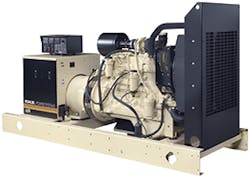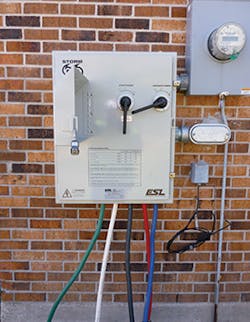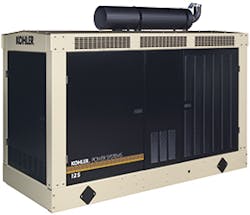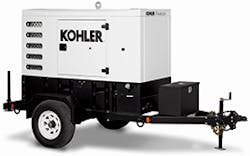The majority of the public considers water utilities and electric utilities to be “sisters”—and, in a lot of ways, they are. However, what very few members of the public consider is that both utilities depend heavily on each other. Electric utilities simply cannot function without water, and water utilities obviously cannot function without electricity.
Of course, there will be times when the power does go out, usually as a result of a major storm, but also for a host of other reasons. As such, it is incumbent on water utilities to arrange for backup power, because, while the public can survive without electricity for days, or even a few weeks, it can’t survive long without fresh water.
Non-Generator Options
Before discussing the pros, cons, and other details associated with permanent and backup generators, it is worthwhile to discuss some other options for backup power.
One of these is alternative (green) power. Does it make sense for a water utility to rely on wind or solar to provide backup power if electricity from the main grid goes out? While such an arrangement does have possibilities, it also has a potential downside, according to Tony Alotto, associate director of the Infrastructure Training and Safety Institute, a division of the Texas Engineering Extension Service (TEEX), at Texas A&M University (College Station, TX).
Prior to his current position, Alotto ran the Public Works Response Team for the State of Texas for five years. “This involved responding to hurricanes, floods, wildfires, and other problems that can cause water operators some angst when it comes to power,” he says.
So what is the downside to relying on alternative power sources as backup? “It is likely that, during a widespread disaster, such as a hurricane, this type of local generation, while it can be useful to offset power costs on a day-to-day basis, is probably going to be damaged or even destroyed, such that it wouldn’t be able to be used anyway. In other words, solar arrays and wind farms will likely be incapacitated.”
A more reliable solution, according to Alotto, is to consider the concept of “dual feed” power. One type of “dual feed” involves having two power lines coming into the plant from different substations that are served by the same utility. As such, if one substation goes down because of a storm, there is a chance that the other substation may remain online. Another type of “dual feed” involves having one power line come in from one utility, and a second power line come in from a second utility.
In fact, this arrangement is in place at Texas A&M. One side of the campus is fed from one utility, and the other side is fed by another utility. “The lines can also be interconnected if one goes out, so that the whole campus maintains power,” says Alotto. “Of course, this type of arrangement doesn’t always protect against large, widespread catastrophic outages, such as during hurricanes.”
Generator Considerations
According to the EPA report “Is Your Water or Wastewater System Prepared? What You Need to Know About Generators,” September 2009: “Loss of electricity quickly becomes a major challenge during natural disasters and could raise public health concerns. Without backup power for an extended period, many water and wastewater services cannot be provided. However, as demonstrated during incidents such as hurricanes and ice storms, not all utilities are prepared to get their systems operational again.”
Generator Number and Size
The pros and cons of permanent generators and portable generators are covered in detail below. However, for some utilities, the decision is going to be based, almost exclusively, on size. That is, very large water utilities will almost always opt for permanent backup generators, while a lot of smaller ones will opt for one or more portable generators.
“If you are an “˜in between’ utility, you can consider both options,” says Richard Traver, technical sales for ESL Power Systems, who has done a lot of work with water and wastewater utilities.
“We sell generators up to 3.2 megawatts,” says James Kukla, manager of channel marketing for Kohler Power Systems. “The most common and popular ones that we have in service at water utilities are between 50 kilowatts and 150 kilowatts. This is determined by how large the pumps are, and the electric motors that power those pumps.”
The size and number of generators are also determined by how much equipment a water utility wants to back up. “One trend we are seeing is that more water plants are interested in backing up their entire facilities, not just certain parts, so that all processes can continue to run,” says Michael Pincus, manager of switchgear systems for Kohler. “One reason is because of their increasing reliance on electronics.”
Needs Identification
It is important to classify electrical needs at your utility. EPA recommends three classifications: Critical Need (equipment that is essential to maintaining public health protection, such as pumps); Secondary Need (equipment that would enhance operations, but is not critical); and Noncritical Need (equipment that is provided for convenience and comfort, but is not essential, such as pumphouse lights). EPA recommends focusing on backup power for Critical Need equipment.
Once you have identified Critical Need electrical equipment, the next step is to determine their voltage, phase configuration, and horsepower/amperage requirements. EPA notes: “Remember, electrical equipment starting power demands are usually two to three times higher than their running demands, which may dictate a larger generator. A licensed electrician can provide assistance in determining your backup power needs.”
The next step is to list the starting order of all of your Critical Need electrical equipment in order to determine your required starting power. EPA notes: “At a minimum, your generator(s) must have the capacity to supply the maximum starting power demand and the running demands of the connected equipment.”
At this point, you will be able to determine your generator needs. There are other things you must consider as well.
Fuel Options
There are four possible types of fuel for generators: diesel, natural gas, propane, and gasoline. EPA notes that diesel generators are the most common and offer the largest selection, availability, and power range (from 4 kW, to more than 2,000 kW).
StormSwitch manual transfer switch
However, according to Kohler’s Kukla, while diesel is still a very popular fuel, there is a trend toward water utilities using more natural gas to power their generators. “Natural gas has become a real convenience, because it can be piped in,” he says. “It is also a cleaner fuel, which is important for meeting EPA regulations. It is also becoming less expensive.”
Perry Hogan, P.E., director of electrical engineering for Burk-Kleinpeter Inc. (New Orleans, LA), an engineering design firm operating in the southeast US, recommends a combination of diesel and natural gas. “Now that diesel generators are available with bifuel kits such that they can also operate on natural gas fuel sources, we usually promote this feature to our clients as a way to extend generator run time,” he says.
Most clients, according to Hogan, are hesitant to rely solely on natural gas generators because, during major tropical storms, a lot of the underground natural gas lines are disabled as a result of damage from roots as trees topple over after strong winds or heavy rain events that saturate the soil. “In addition, diesel fuel is relatively easy to transport in the aftermath of a major tropical storm,” he says. “The National Guard and other military units will usually show up with big trucks filled with diesel, and will usually bring these to the highest-need facilities, which include water utilities.”
Hookups
Once generators and fuel sources are identified, the next step is to determine how they will be connected to the plant’s power system. As EPA observes: “Generators do not simply plug into a piece of equipment that you would like to power. You have to install a connection that will enable you to rapidly hook up the generator to your well or sewer lift station pumps, and not accidentally “˜backfeed’ electricity into utility company lines, which could electrocute a line worker.”
Location Options
The next step is to determine the location of the generator(s). It is important to take into account environmental considerations and site considerations. With the former, for example, generators and their fuel storage tanks must be located above potential floodwater levels and should also be protected with weatherproof enclosures. With the latter, generators need to be on flat surfaces, such as concrete slabs, and be located in well-lit or patrolled areas to avoid theft and vandalism.
Permanent (Indoor) Generators
As is the case with portable generators, permanent indoor generators have some pros and some cons.
The Pros
Permanent generators are set up to ensure that the transfer of power from the utility to the generator is immediate and seamless if the utility’s power goes out. “As such, if you have certain applications that are deemed critical, you just need to have a permanent generator,” says ESL Power’s Traver.
According to Burk-Kleinpeter’s Hogan, indoor generators are typically less expensive to install if you are replacing
Commercial gas generator
existing generator sets. “Indoor generators can also usually be serviced regardless of the exterior weather conditions,” he says.
The Cons
“One concern is that indoor generators are quite expensive, especially when you consider the fact that they end up rarely ever being used,” says TEEX’s Alotto. “There are also the time and costs associated with having to maintain it and test it on a regular basis.”
TEEX typically doesn’t recommend having permanent onsite generators in Texas, especially along the coast, because the same storm that damages a facility and takes out the main power is also likely to take out the generator, especially from flooding that results from hurricanes. “However, there are some locations where they can be protected, such as behind brick walls, and high enough to avoid flood damage,” he says.
Maintenance
EPA identifies 14 Operation and Maintenance tips. These are:
- Exercise your generator periodically under the actual electrical load required of the unit to keep it ready for use.
- Develop a “start and connect” checklist specific to each individual generator, and keep it where staff can easily find it.
- Do not operate the generator in excess of its rated capacity.
- Be sure the generator is properly grounded.
- Keep portable generators outside and at least 10 feet away and downwind from inhabited, enclosed areas to prevent the buildup of carbon monoxide fumes.
- Maintain 3 to 4 feet of clear space on all sides and above the generator for adequate ventilation.
- Perform scheduled maintenance as recommended by the generator manufacturer.
- Incorporate fuel management into the maintenance schedule to ensure availability of clean, reliable fuel.
- Do not refuel the generator while it is running. Turn it off first. Let it cool, especially if the generator uses gasoline.
- Keep the generator dry by keeping it elevated and away from possible flooding.
- Support electrical cords off the ground, and do not let cords run through low-lying areas or puddles.
- Replace any cords with damaged insulation.
- Train all staff on how to operate the generator safely.
- Wear hearing protection if you have to work close to a generator.
Connection and Testing
Most permanent generators are connected with automatic transfer switches, such that, if the power goes out, the switches automatically activate the generators by switching from the utility to the generator.
Mobile diesel generator
In some instances, according to ESL Power’s Traver, especially if the utility has a super-critical device, they may have an interim power source, which is called an uninterrupted power supply (UPS), which is basically a large bank of batteries. “If the power goes out, the system automatically switches to the UPS within 10 to 15 milliseconds,” he says. “The UPS can then power these devices for a short period of time, which is typically enough time to get the permanent backup generator up to a level of performance that will allow it to continue to function to power those critical sources.”
One product that ESL Power Systems offers is called TripleSwitch, a three-way transfer switch that uses three interlocked disconnects to isolate standby generator circuits during Critical Operation Power Systems (COPS) load bank testing. This eliminates the need to strip and reconnect connections each and every time. This is handled automatically with cam connections. It can also double as a manual transfer switch to provide a quick and safe method to connect to a portable generator for redundant backup power.
“The TripleSwitch is designed such that, depending on the code for the state, county, or city that requires testing of the permanent backup generator to make sure it is working properly, in case of an emergency, there is a reasonable expectation that the generator will work,” says Traver. “Over time, governing bodies have started to make these requirements more stringent. One reason is that, after some of these large storms we have had around the country, it turned out that a lot of these permanent backup generators simply didn’t work. And, they find out, they had never been tested.”
There are two standard load bank tests that are done on permanent generators. One is the 30/30 test. This involves activating the generator, bringing it up to 30% of its load capacity, and running it for 30 minutes.
“It’s not a long test, but you still need to go through all of the same procedures that you would if you were running a long load bank test,” says Traver.
The other is the 100% test, which involves activating the generator and running it to 100% of capacity for four to six hours. In order to run these tests without a product like TripleSwitch, you need to disconnect the generator from the utility side, bring in the load bank test, hook it up, turn the generator on, run the test, disconnect the load bank, and reconnect to the utility. In the meantime, you need to be sure you have some standby power available in case the generator doesn’t function properly.
“It takes a lot of people, a lot of time, and a lot of money to conduct these load bank tests,” says Traver.
The TripleSwitch, on the other hand, is designed to make these tests considerably quicker and easier, and reduce the overall cost. For example, some jurisdictions require the 30/30 test once a quarter or six times a year, and the 100% test once a year, thus requiring five or more total tests per year. Besides running the load bank tests, the TripleSwitch also provides the connection to a portable generator that is required to be there for standby in case the permanent generator fails during the testing.
“As such, the TripleSwitch pays for itself, because it reduces the costs associated with performing the tests that are required by the governing bodies,” he says.
Portable Generators
The Pros
“If a client is considering a new generator installation, we typically look to outdoor rated generator sets, as they are more economical,” says Burk-Kleinpeter’s Hogan.
Additional benefits of portable generators, according to ESL Power’s Traver, are that you don’t have a permanent asset on the books, you don’t have the costs associated with maintaining and testing them, and you don’t have the costs associated with having spare parts available.
“In addition, you don’t need to make a special space available, as you would with a permanent backup generator,” he says.
The Cons
One drawback to using portable generators is that you don’t have immediate and instantaneous access to backup power. In addition, you have the costs associated with paying the generator provider from whom you rent or lease the generators for the privilege of making sure that generators will be available within a certain timeframe when you need them.
“There are also the costs associated with actually using them, which can get expensive if you need to use them for several days,” says Traver.
According to Traver, a lot of water utilities, particularly in the East, utilize a concept called a “consigned generator.” During hurricane season, they consign with their generator provider to bring a generator to the site, and it sits onsite for five or six months.
“During this time, the provider is charging you to have the generator sit there, and charging you to service it while it’s there,” he says.
Access Arrangements
While some water utilities that don’t have permanent backup generators will want to purchase their own portable generators, this isn’t always necessary, as noted above, in that you can arrange to rent or lease these generators when they are needed.
Besides renting and leasing, there are some other options for gaining access to portable generators when they are needed, according to TEEX’s Alotto. One option is to share generators with a neighboring utility that has a similar plant to yours, but that is far enough way that you’re not both likely to need it at the same time (100 or 200 miles away, for example, would make it far enough away that you probably both won’t need it at the same time, but close enough that it won’t take too long to deliver it).
Another option is to become part of a consortium, such as the various state WARN Networks that have been created by the American Water Works Association. These consist of networks of utilities that help each other in times of disaster.
“In Texas, the members of the consortium have a number of portable generators and pledge to support each other during an outage,” says Alotto.
Regardless of what kind of arrangement you have for gaining access to portable generators, it is still important to conduct some work in advance. For example, you need to:
- bring in an electrician in advance so you can identify the critical parts of your plant that need to be isolated, such as the main pump;
- set up the wiring and equipment so that you can connect quickly to the generator;
- determine the size that your backup generator(s) need(s) to be; and then
- have a place where the generator(s) can be parked and quickly connected.
“Be sure the location is convenient and accessible, so you can refuel it as needed and conduct maintenance as required,” says Alotto. “However, the location also needs to be secure. Otherwise, especially when the power is out, the generators have a tendency to “˜walk off.'”
Hookup and Testing
One helpful tool for connecting and testing portable generators is a product offered by ESL Power Systems called TempTap. This is a portable generator connection box, which provides a way to temporarily connect a portable generator to a facility. Plants that have permanent standby generators have the option of using either the TempTap or TripleSwitch (discussed earlier).
“The TempTap is not the better option of the two, but it is less expensive,” says Traver. “It allows them to hook up the generator docking station through the automatic transfer switch, which signals the permanent generator to start up when an emergency occurs, and switches power from the utility side to the generator side.”
If the permanent standby generator is going to have maintenance performed, some utilities will install a generator docking station through the automatic transfer switch, so they can quickly hook up the portable generator. “However, this doesn’t allow them to do their load bank testing, so it is only half a solution,” says Traver.
Still, though, in some cases, because of regulations that may require load bank testing on the permanent standby generator only once a year, the utilities will forgo the convenience of the TripleSwitch and just have a generator docking station. “So, when they do their load bank testing, they still have some provisions to quickly hook up a portable generator,” he says.
A lot of smaller water utilities use the TempTap, according to Traver, because they can’t afford a TripleSwitch, even though it is a better solution.
Remote Hookups
While providing power to the main plant is of most importance, it is also important to make sure that other locations have power. One effective tool for this is ESL Power’s StormSwitch, a manual transfer switch that provides an economical solution for businesses that want to be prepared for emergency power loss. It ensures a simple hook-up to a portable power generator during a power outage.
“This is used extensively in remote locations where there are pumps that are critical to the operation of the system, but where there are not permanent standby generators in place,” says Traver.
These may include lift stations and bypass stations. The utility can install a StormSwitch at each location. Then, it can contract with a generator vendor in the area such that, if the power goes out, the vendor can deliver the generators to the remote locations.
“Since the StormSwitch is already in place at the station, the company’s employees can hook the generator up and start it up,” he says. “The water utility doesn’t need to send anyone out there at all. The generator company can handle everything, as long as the StormSwitch is in place.”
There is also an option to include remote monitoring on the StormSwitch. “For this, we will provide the contact and wiring through the breakers, and the utility can provide a signaling device, such as Wi-Fi, that will monitor the StormSwitch from a remote location,” he says.
Then, if there is an outage, the signal goes to the central utility office, which then sends a request to the generator provider, which then delivers the generator to the station and hooks it up.
A small water utility may actually install one, two, or even three StormSwitches at the utility itself, and the generator provider will usually be able to provide one, two, or even three generators within 30 minutes to power certain critical functions of the facility, such as one to the control building (to make sure the computers can run), one to power the air conditioning which air conditions the computers, and one to the pump station.
“However, we have found that, if a utility needs more than three portable generators, it should probably be looking at a permanent standby generator,” says Traver.
Resources For more information on generators, go to www.egsa.org. This is the website of the Electrical Generating systems Association (EGSA), an association dedicated to onsite power generation that includes over 500 companies that manufacture, sell, distribute, and use power generation technology and equipment.





